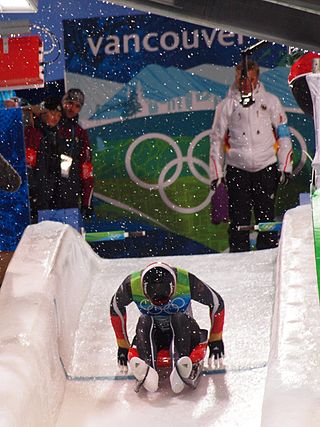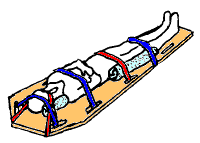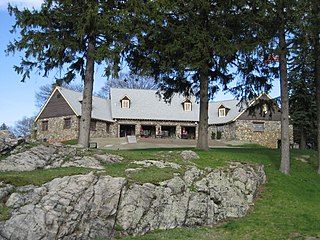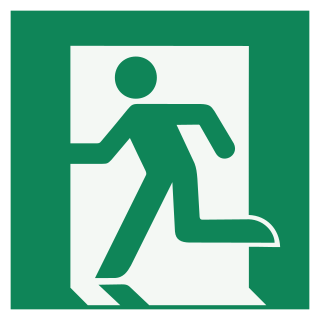
A luge is a small one- or two-person sled on which one sleds supine and feet-first. A luger steers by using the calf muscles to flex the sled's runners or by exerting opposite shoulder pressure to the seat. Racing sleds weigh 21–25 kg (46–55 lb) for singles and 25–30 kg (55–66 lb) for doubles. Luge is also the name of an Olympic sport.

A sled, skid, sledge, or sleigh is a land vehicle that slides across a surface, usually of ice or snow. It is built with either a smooth underside or a separate body supported by two or more smooth, relatively narrow, longitudinal runners similar in principle to skis. This reduces the amount of friction, which helps to carry heavy loads.

An elevated passenger ropeway, or chairlift, is a type of aerial lift, which consists of a continuously circulating steel wire rope loop strung between two end terminals and usually over intermediate towers, carrying a series of chairs. They are the primary onhill transport at most ski areas, but are also found at amusement parks, various tourist attractions, and increasingly in urban transport.

A snowmobile, also known as a Ski-Doo, snowmachine, sled, motor sled, motor sledge, skimobile, or snow scooter, is a motorized vehicle designed for winter travel and recreation on snow. It is designed to be operated on snow and ice and does not require a road or trail, but most are driven on open terrain or trails. Snowmobiling is a sport that many people have taken on as a serious hobby.

Rope rescue is a subset of technical rescue that involves the use of rope, be it steel or cable rope, or more commonly used nylon, polyester, or other type of rope. Kernmantle rope as it is called, is available in various types: dynamic or static which is most commonly used in rescue and industrial rope work. Anchoring includes using specialty anchors, as well as things as simple as a length of chain, cable, rope, or webbing wrapped around a pillar, tree, boulder, or such. They provide the security and a point from which a person or subject can be belayed. Belaying is the act of protecting the climber, rescue professional, or subject in the event of a fall. Various other devices used, including friction rappel (lowering) devices, which acts as a braking device on the rope. They are used for lowering a load, a subject or oneself (rappelling). Pulleys can serve as a mechanical advantage, along with rope grabs, and other tools, to raise, or haul, a load up a vertical section, or across a gully or canyon. Pulleys systems are used in conjunction with the rope, rope grabbing devices, i.e.: Prusiks, or mechanical grabs, to capture the progress made during the lift. Since pulley systems are generally short in length, they are used in conjunction with a progress (raise) capturing technique, and a long rope; and a backup safety or belay. This specialized equipment is used to reach the subject(s) and safely recover them.

Abseiling, also known as rappelling, is the controlled descent of a steep slope, such as a rock face, by moving down a rope. When abseiling the person descending controls their own movement down the rope, in contrast to lowering off in which the rope attached to the person descending is paid out by their belayer.

Sledding, sledging or sleighing is a winter sport typically carried out in a prone or seated position on a vehicle generically known as a sled, a sledge (British), or a sleigh. It is the basis of three Olympic sports: luge, skeleton and bobsledding. When practised on sand, it is known as a form of sandboarding. In Russia sledges are used for maritime activities including fishing and commuting from island to island on ice.

A stretcher, gurney, litter, or pram is an apparatus used for moving patients who require medical care. A basic type must be carried by two or more people. A wheeled stretcher is often equipped with variable height frames, wheels, tracks, or skids. Stretchers are primarily used in acute out-of-hospital care situations by emergency medical services (EMS), military, and search and rescue personnel. In medical forensics the right arm of a corpse is left hanging off the stretcher to let paramedics know it is not a wounded patient. They are also used to hold prisoners during lethal injections in the United States.

A toboggan is a simple sled traditionally used by children. It is also a traditional form of transport used by the Innu and Cree of northern Canada.
Automobile handling and vehicle handling are descriptions of the way a wheeled vehicle responds and reacts to the inputs of a driver, as well as how it moves along a track or road. It is commonly judged by how a vehicle performs particularly during cornering, acceleration, and braking as well as on the vehicle's directional stability when moving in steady state condition.

A spinal board, is a patient handling device used primarily in pre-hospital trauma care. It is designed to provide rigid support during movement of a person with suspected spinal or limb injuries. They are most commonly used by ambulance staff, as well as lifeguards and ski patrollers. Historically, backboards were also used in an attempt to "improve the posture" of young people, especially girls.

Ski patrols are organizations that provide medical, rescue, and hazard prevention services to the injured in ski area boundaries, or sometimes beyond into backcountry settings. Many have technical-medical certifications, such as Outdoor Emergency Care (OEC) provided by the National Ski Patrol (USA), that are specific to the winter-season environment and providing emergency medical services in remote locations. Many patrollers also hold EMS issued credentials, such as emergency medical technician or any other pre-hospital care certification. Due to the remote location and terrain, transportation is often limited to Rescue toboggan, snowmobile, or, for life-compromising injuries or extremely remote terrain, helicopter rescue. Depending on the ski area terrain, ski patrollers can be versed in a large variety of specialized rescues, such as avalanche search and rescue, outdoor emergency transportation, chairlift evacuation, and, in some cases, helicopter rescue techniques are taught. Patrols work to promote ski safety, enforce area policies, and help the injured within their jurisdiction. Ski patrollers also work to set up the mountain before it opens by conducting trail checks, providing avalanche control work, and setting up necessary equipment in preparation for the day. At the end of the day, they also conduct a sweep clearing the mountain for off-hours.

The nonprofit National Ski Patrol (NSP) is the largest winter education organization in the world. The NSP provides education, outreach, and credentialing related to outdoor recreation and safety. It is currently composed of more than 31,000 members who serve in over 650 patrols. NSP members, both volunteer and paid, ensure the safety of outdoor recreation enthusiasts in ski areas throughout the United States of America and certain military areas of Europe. For its dedication to the promotion of public safety in skiing and other winter sports, the group was granted a congressional charter under Title 36 of the United States Code in 1980.

A Prusik is a friction hitch or knot used to attach a loop of cord around a rope, applied in climbing, canyoneering, mountaineering, caving, rope rescue, ziplining, and by arborists. The term Prusik is a name for both the loops of cord used to tie the hitch and the hitch itself, and the verb is "to prusik". More casually, the term is used for any friction hitch or device that can grab a rope. Due to the pronunciation, the word is often misspelled Prussik, Prussick, or Prussic.
The Canadian Ski Patrol is a national, non-profit, registered charitable organization that is volunteer-based and provides advanced first aid and emergency response services at more than 230 ski resorts and nordic centres, as well as hundreds of recreational and sporting events across Canada. The Canadian Ski Patrol (CSP) has more than 4,500 registered members consisting of alpine and nordic skiers, snowboarders, and non-skiers/boarders, making it the largest volunteer-based certified first responder organization in Canada. Members of the CSP are involved in accident prevention and intervention, managerial activities, and patroller and public education.

A litter is a stretcher or basket designed to be used where there are obstacles to movement or other hazards: for example, in confined spaces, on slopes, in wooded terrain. Typically it is shaped to accommodate an adult in a face up position and it is used in search and rescue operations. The person is strapped into the basket, making safe evacuation possible. The person generally is further protected by a cervical collar and sometimes a long spine board, so as to immobilize the person and prevent further injury.

Mount Hood is an 18 hole golf club and park located in Melrose, Massachusetts. It was built in the 1930s on donated land as part of President Franklin D. Roosevelt's Works Progress Administration and once consisted of a ski area. Today, Mount Hood serves as a golf course and park, while sledding is popular in the winter.
A specialized set of jargon describe the tools, equipment, and employment sectors used in the trucking industry in the United States. Some terms may be used within other English-speaking countries, or within the freight industry in general. For example, shore power is a term borrowed from shipping terminology, in which electrical power is transferred from shore to ship, instead of the ship relying upon idling its engines. Drawing power from land lines is more efficient than engine idling and eliminates localized air pollution. Another borrowed term is "landing gear", which refers to the legs which support the front end of a semi-trailer when it is not connected to a semi-truck. Some nicknames are obvious wordplay, such as "portable parking lot", in reference to a truck that carries automobiles.

A summer toboggan is an amusement or recreational ride which uses a bobsled-like sled or cart to run down a track usually built on the side of a hill. There are two main types: an Alpine coaster or mountain coaster is a type of roller coaster where the sled runs on rails and is not able to leave the track, whereas with an Alpine slide the sled simply runs on a smooth concave track usually made of metal, concrete or fiberglass. Both of these types of ride are sometimes denoted with the German name Sommerrodelbahn.

ISO 7010 is an International Organization for Standardization technical standard for graphical hazard symbols on hazard and safety signs, including those indicating emergency exits. It uses colours and principles set out in ISO 3864 for these symbols, and is intended to provide "safety information that relies as little as possible on the use of words to achieve understanding."




















